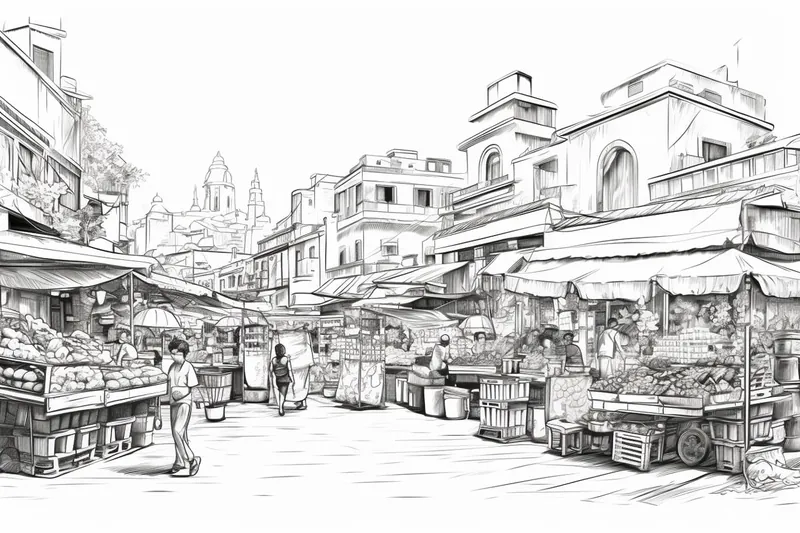How to Draw a City Market
Learn how to draw a city market and capture its bustling energy and unique architecture in your drawings with our comprehensive guide. Master techniques to create stunning urban sketches and bring your artwork to life.

Materials You'll Need
- Pencil
- Paper
- Eraser
 Learning how to draw a City Market can be an exhilarating adventure that transports you into the heart of a bustling urban landscape. These markets are alive with energy, featuring an array of vibrant sights, cheerful sounds, and enticing smells. From colorful stalls brimming with fresh produce to the lively chatter of diverse vendors, every corner of a City Market offers a new story waiting to be captured. As an artist, you have the unique opportunity to translate this dynamic atmosphere onto paper, creating a visual experience that reflects the essence of city life.
Learning how to draw a City Market can be an exhilarating adventure that transports you into the heart of a bustling urban landscape. These markets are alive with energy, featuring an array of vibrant sights, cheerful sounds, and enticing smells. From colorful stalls brimming with fresh produce to the lively chatter of diverse vendors, every corner of a City Market offers a new story waiting to be captured. As an artist, you have the unique opportunity to translate this dynamic atmosphere onto paper, creating a visual experience that reflects the essence of city life.
However, rendering the vibrancy and complexity of a City Market can be both inspiring and challenging. It requires not only a keen eye for detail but also an appreciation for composition and perspective. By observing the interactions of people, the layout of the stalls, and the variety of items for sale, you can depict the market's spirit in your artwork. In this guide, we will delve into effective techniques and practical tips that will enable you to draw the lively scenes of a City Market with confidence and flair.
So, are you ready to unleash your creativity? Grab your sketchbook and a set of pencils as we embark on this artistic journey together. Get ready to explore the fascinating world of urban sketching, where you will learn to bring the vibrancy of a City Market to life in your drawings!
Materials Required
- Drawing paper
- Pencils (2B, 4B, 6B)
- Eraser
- Blending stumps
- Colored pencils or markers (optional)
Step 1: Research and Reference
Begin by researching different city markets to gather inspiration. Look at photographs, videos, and illustrations to understand the structure and layout of a typical city market.
Step 2: Materials
Gather your drawing materials, including paper, pencils, erasers, and a ruler. You may also want to use colored pencils or markers for added detail and dimension.
Step 3: Composition Planning
Sketch a rough outline of your city market composition. Decide on the perspective you want to portray – whether it's a bird's eye view, street level view, or a close-up of a specific section of the market.
Step 4: Basic Shapes and Structures
Start by sketching the basic shapes and structures of the city market. Use simple geometric shapes like rectangles, squares, and triangles to outline the buildings, stalls, and market tents.
Step 5: Adding Details
Add details to your city market drawing, such as windows, doors, signs, and people. Pay attention to the architectural features of the buildings and the variety of goods on display at the market stalls.
Step 6: Textures and Patterns
Incorporate textures and patterns to bring your city market drawing to life. Use cross-hatching or shading techniques to create depth and dimension in the buildings and surroundings.
Step 7: Adding Color
If you choose to add color to your drawing, use colored pencils or markers to fill in the details. Consider the lighting and atmosphere of the scene to determine the color palette for your city market.
Step 8: Final Touches
Review your drawing and make any necessary adjustments or additions. Add final touches such as shadows, highlights, and small details to enhance the overall composition.
Step 9: Sign and Date
Sign and date your finished city market drawing to mark its completion and add a personal touch to your artwork.
Step 10: Share Your Artwork
Display your city market drawing proudly or share it with others to showcase your creativity and artistic skills.
Tip: When drawing a City Market, start by sketching a loose layout of the scene using light pencil strokes to block in the main elements, such as stalls, pathways, and people. Focus on capturing the perspective by using vanishing points to ensure that your stalls and structures recede naturally into the background. To convey the lively atmosphere, incorporate a variety of shapes and sizes for the stalls and objects, and don't hesitate to exaggerate certain features to enhance visual interest. Use a mix of textures and shading techniques—like cross-hatching and stippling—to differentiate between materials, such as wooden stalls and shiny produce. Finally, consider adding small details, like signage and crowds, to breathe life into your market scene; these elements will help convey the bustling energy that makes a City Market so vibrant.
Conclusion
Great job on your drawing of the City Market! Your attention to detail and use of perspective really bring the scene to life. Remember, art is a journey and each piece you create helps you grow as an artist. Keep practicing, experimenting with different techniques, and pushing yourself out of your comfort zone. Your dedication and passion for art will continue to shine through in your work. Keep creating and exploring the world around you through your art. The possibilities are endless!
Fun Facts About City Markets
- City Markets are vibrant hubs of activity where locals and tourists gather to buy fresh produce, artisan goods, and unique items.
- Many City Markets have a rich history dating back centuries, with some originating as far back as medieval times.
- City Markets often feature a diverse array of vendors, selling everything from fruits and vegetables to flowers, handicrafts, and clothing.
- Some City Markets host special events such as food festivals, cooking demonstrations, live music performances, and cultural celebrations.
- City Markets are great places to discover local flavors and regional specialties, allowing visitors to experience the unique tastes of a city or region.
- Many City Markets are located in historic buildings or picturesque settings, adding to their charm and appeal.
- City Markets are not just places to shop – they also serve as social gathering spots where people can connect, interact, and enjoy the bustling atmosphere.
- Some City Markets have become popular tourist attractions in their own right, drawing visitors from around the world who seek an authentic and immersive cultural experience.
- City Markets play an important role in supporting local farmers, artisans, and small businesses, helping to promote sustainable and ethical shopping practices.
- The sights, sounds, and smells of a City Market create a sensory experience that engages all the senses and leaves a lasting impression on visitors.
Suggestions for Scenes and Settings for City Market Drawings
- Early morning at the city market, with vendors setting up their stalls and the sunlight streaming through the trees.
- A bustling lunchtime scene at the market, with people enjoying food from different stalls and musicians playing in the background.
- A view of the market at dusk, with the lights from the stalls creating a warm and inviting atmosphere.
- A rainy day at the market, with vendors hurriedly covering their goods and shoppers using colorful umbrellas.
- A quiet moment at the market in the evening, with a lone vendor packing up their stall against a backdrop of colorful buildings.
- A panoramic view of the entire market, showcasing the diversity of products being sold and the mix of people visiting.
- A close-up of a specific stall selling fresh produce or flowers, capturing the vibrant colors and textures.
- A sketch of the market's architecture, highlighting the unique buildings and street signs.
- An overhead view of the market, showing the layout of the stalls and the flow of people moving through the space.
- A scene of the market during a special event or festival, with decorations and performances adding to the festive atmosphere.